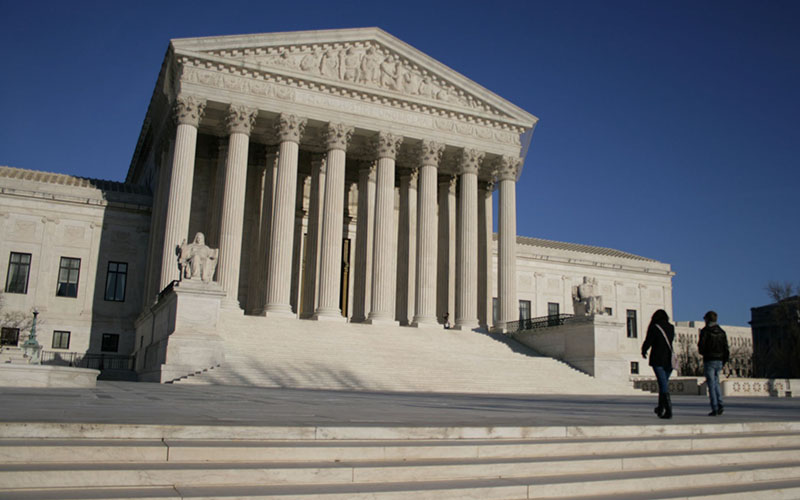WASHINGTON – In the quarter-century that James Erin McKinney has been on Arizona’s death row, sentencing rules have changed and so has understanding of post-traumatic stress disorder and its impact on human behavior.
But McKinney’s death sentence remains the same.
The Supreme Court will be asked Wednesday to consider whether he should stay on death row or if a jury should be allowed to hear his argument that psychological trauma from his “horrific” childhood should be considered when weighing the death penalty.
The decision could affect as many as 19 other death row inmates who were sentenced under the same guidelines as McKinney, his attorneys say.
“In 1982, before McKinney was tried, the United States Supreme Court … said that a sentencer on a death penalty case could not exclude any kind of mitigating evidence,” said James Hamm, director of legislative and program services at Middle Ground Prison Reform. “When (McKinney) was sentenced, the sentencing court excluded all mitigating evidence that was not directly connected to the crime itself.”
McKinney and his half-brother, Charles Hedlund, were convicted by separate juries in a string of Phoenix-area burglaries in 1991 that ended in two murders.
The first occurred on March 10 when the two men broke into the home of Christine Mertens, whom they beat and stabbed before holding her on the floor and shooting her in the back of the head at point-blank range.
Roughly two weeks later, the two men broke into the home of James McClain, who was asleep at the time. McClain was shot in the head at close range with a sawed-off rifle before McKinney and Hedlund stole McClain’s watch, three handguns and his car.

James McKinney has been on Arizona’s death row since 1993 for two murders committed with his half-brother during burglaries in the Phoenix area in 1991. (Photo courtesy Arizona Department of Corrections)
McKinney was convicted in 1992 on two counts of first-degree murder, two counts of burglary and one count of theft. Hedlund was convicted of the same theft and burglary charges, as well as first-degree murder for McClain’s death and second-degree murder of Mertens.
Both men were sentenced to death in 1993 by Maricopa County Superior Court Judge Steven Sheldon, who took into account troubled childhoods of the defendants that were “beyond the comprehension of most people.”
Those abuses included regular beatings by McKinney’s stepmother, an alcoholic father, a filthy home life that included living with livestock in the house, and repeatedly being locked out of the house without food or water in Arizona, said Robert Dunham, executive director of the Death Penalty Information Center.
But because those factors did not have a “causal nexus” – or direct link – to the crime, Sheldon said he could not weigh them against factors arguing for death, including previous convictions, crimes committed for monetary gain and the “especially heinous, cruel or depraved” nature of the murders McKinney committed.
The Arizona Supreme Court upheld McKinney’s sentence in 1996.
But a divided 9th U.S. Circuit Court of Appeals ruled in McKinney’s case in 2015 that Arizona courts had wrongly applied the causal nexus test for as long as 15 years after the U.S. Supreme Court’s 1982 ruling that all mitigating evidence had to be considered in a capital sentencing.
“They’ve been violating this rule for many, many years – and we’re talking about a rule of law that is the United States Supreme Court rule of federal constitutional law,” Hamm said.
Similar violations may have occurred in the sentencing of 19 other inmates who have spent decades on death row and were found to have aggravating circumstances that included “especially heinous, cruel, or depraved” murders.
On remand, the Arizona Supreme Court in 2018 said it considered all the factors in McKinney’s case, but that they still weighed in favor of a death sentence.
McKinney’s attorneys have challenged that, too, saying a 2002 U.S. Supreme Court ruling requires that juries – not judges – impose death sentences. But the Arizona Supreme Court said it only had to apply the law in effect at the time that McKinney’s conviction became “final” – when it first upheld his conviction in 1996.
Advocates say it’s hard to say precisely whether McKinney’s crimes were a result of his PTSD, but that a resentencing is called for so a jury can make that decision.
“Childhood maltreatment is one of the most pernicious forms of trauma a human can endure,” Dr. Victoria Reynolds, a clinical psychologist who specializes in the assessment and treatment of traumatic life experiences, said in a conference call. She said the trauma that can develop from such a childhood “is every bit as destructive, disruptive, and disabling in the lives of children as PTSD resulting from combat exposure.”
Symptoms can include deregulated brain function, altered impulse control and slowed defenses, among others, Reynolds said. Because the severity of PTSD is better understood now, she said, a jury listening to his case would be doing so with more information than the judge had in 1992.
A jury hearing is “the appropriate remedy to ensure that each individual gets the individualized sentencing that the Constitution requires,” said Jordan Steiker, a professor at the University of Texas School of Law. “And we’re not dealing with so many cases that it’s either by cost or by time infeasible to administer.”
Arizona Attorney General Mark Brnovich’s office did not respond to a request for comment on the case. But in its brief to the U.S. Supreme Court, the state said the Arizona Supreme Court’s 2018 ruling was correct. If the high court agreed with McKinney that a 2002 ruling should apply to a case the state says ended in 1996, “there would be no such thing as ‘finality’ in capital cases … or criminal cases generally,” the state’s brief said.
It’s not guaranteed that a resentencing would remove McKinney, or any of the other inmates cited in his petition, from death row. But legal experts say that a second look might still be necessary to correct the sentencing errors that occurred years ago.
“In all fairness, despite the heinousness of the crime, we should give them a new sentencing hearing,” Hamm said. “It’s just a question of how serious the state is about correcting its errors.”
Hamm said the state needs to make amends, “because the errors made from 1982 all the way up until about 2005 were a clear violation.”
“The U.S. Supreme Court had clearly said you cannot exclude non-causally related mitigating evidence, and Arizona continued to do it for 15 years,” he said. “So now they’ve been caught on it, and the question is how they’re going to correct it.”

